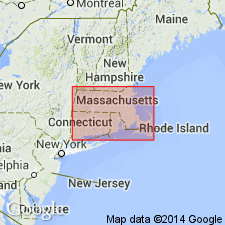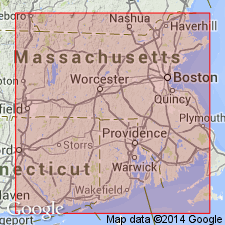- Usage in publication:
-
- Dighton conglomerate group
- Modifications:
-
- Original reference
- Dominant lithology:
-
- Conglomerate
- Sandstone
- AAPG geologic province:
-
- New England province
Summary:
Pg. 134, 184-187, and pl. 17. Dighton conglomerate group. The name Dighton conglomerate is here given to a group of coarse conglomerates, with alternations of sandstone, found as highest member of the Carboniferous in Dighton, Somerset, and Swansea, in [Bristol County], southeastern Massachusetts. The coarsest conglomerate bed is at base of formation. Thickness 1,000 to 2,000+/- feet. Rests on Rhode Island Coal Measures. Correlated with Purgatory conglomerate of Rhode Island.
Source: US geologic names lexicon (USGS Bull. 896, p. 609-610).

- Usage in publication:
-
- Dighton conglomerate*
- Modifications:
-
- Areal extent
- AAPG geologic province:
-
- New England province
Summary:
Pg. 51-55, and map. Dighton conglomerate. Long lenses of peculiar conglomerate infolded in Rhode Island formation. Regarded same as Purgatory conglomerate of Rhode Island. [Age is Carboniferous.]
Source: US geologic names lexicon (USGS Bull. 896, p. 609-610).

- Usage in publication:
-
- Dighton Conglomerate*
- Modifications:
-
- Areal extent
- AAPG geologic province:
-
- New England province
Summary:
Dighton Conglomerate. A coarse conglomerate having sandy matrix and minor sandstone. Age is Late Pennsylvanian [no explanation given for this age refinement.]
Source: Modified from GNU records (USGS DDS-6; Reston GNULEX).

- Usage in publication:
-
- Dighton Conglomerate
- Modifications:
-
- Revised
- Dominant lithology:
-
- Conglomerate
- AAPG geologic province:
-
- New England province
Summary:
Dighton Conglomerate of /Rhode Island Group. Gray conglomerate dominantly of quartzite cobbles to boulders and lesser granite and slate; little sandstone matrix; lenses of medium sandstone. Thickness 300 to 450 m. Is top formation of /Rhode Island Group. Overlies Rhode Island Formation of /Rhode Island Group. Is very similar to the Purgatory Conglomerate; may represent an overthrust of the Purgatory. Fossils (nondiagnostic plant debris). Age is considered Late Pennsylvanian (possibly Stephanican B? or C?).
Recognized in northern Narragansett Basin.
[Rhode Island Group in conflict with nomenclatural guidelines stating it is not permissible to apply the same name to a unit and to a part of it (CSN, 1933; ACSN, 1961, 1970; NACSN, 1983, 2005, 2021). As applied in this report, Rhode Island Group considered invalid.]
Source: GNU records (USGS DDS-6; Reston GNULEX).

- Usage in publication:
-
- Dighton Conglomerate*
- Modifications:
-
- Overview
- AAPG geologic province:
-
- New England province
Summary:
Dighton Conglomerate occurs in Narragansett basin. Consists of gray conglomerate composed mainly of rounded quartzite cobbles to boulders containing subordinate rounded granite cobbles and slate pebbles; very little sand matrix; lenses of medium-grained sandstone form less than 20 percent of unit. Age is Pennsylvanian. Report includes geologic maps, correlation charts. [Chapters A-J in U.S. Geological Survey Professional Paper 1366 are intended as explanations and (or) revisions to the 1:250,000-scale MA State bedrock geologic map of Zen and others (1983).]
Source: GNU records (USGS DDS-6; Reston GNULEX).
- Usage in publication:
-
- Dighton Conglomerate*
- Modifications:
-
- Mapped
- Dominant lithology:
-
- Conglomerate
- AAPG geologic province:
-
- New England province
Summary:
(credited to Sharon Mosher, Univ. Texas-Austin, and co-workers.) Dighton Conglomerate of Narragansett Bay Group. Gray conglomerate consisting predominantly of quartz clasts set in a sand-sized matrix. Minor lenses of litharenite and arkosic sandstone. Age is Pennsylvanian. [This definition of the Dighton is adopted by the USGS.]
[Notable exposures north of Bristol, RI, along RI-MA State line, around Lat. 41 deg. 45 min. N., 71 deg. 00 min. W.]
Source: Publication.
For more information, please contact Nancy Stamm, Geologic Names Committee Secretary.
Asterisk (*) indicates published by U.S. Geological Survey authors.
"No current usage" (†) implies that a name has been abandoned or has fallen into disuse. Former usage and, if known, replacement name given in parentheses ( ).
Slash (/) indicates name conflicts with nomenclatural guidelines (CSN, 1933; ACSN, 1961, 1970; NACSN, 1983, 2005, 2021). May be explained within brackets ([ ]).

